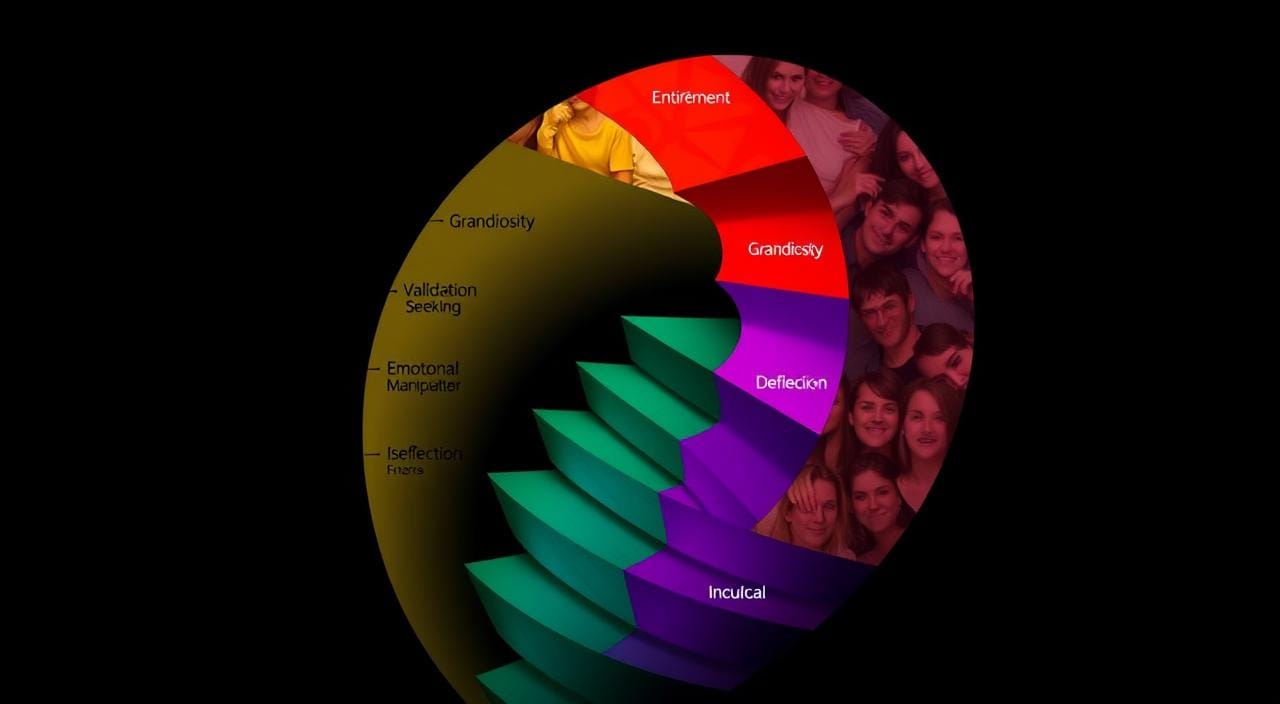Looking back, I’ve been in three narcissistic relationships over 49 years1. The third one was the hardest, making me see a pattern. I started therapy, a journey that lasted two and a half years1. But, I found out that friends and family often don’t get it because they haven’t been abused themselves. So what to do When no one believe he is abusive?
Friends have struggled to believe in the cruelty of narcissists1. They don’t see how narcissists can be so heartless and treat people like objects1. This misunderstanding has made my trauma worse, leaving me feeling very alone. So, I’m writing this guide to help others understand narcissistic abuse1. I hope it will help others avoid the loneliness and disbelief I’ve faced.
Key Takeaways
- Narcissistic abuse can occur in multiple relationships, with a 6.12% occurrence rate over 49 years.
- Seeking therapy for narcissistic abuse can be a lengthy process, taking 2.5 years for the author.
- Hundreds of other women have shared their experiences of narcissistic abuse, highlighting the prevalence of this issue.
- Narcissists are often underreported due to their lack of seeking therapy, making it difficult to accurately assess the prevalence of Narcissistic Personality Disorder (NPD).
- Understanding the distinct characteristics of overt and covert narcissists can help identify and address narcissistic abuse.
The Cycle of Narcissistic Abuse
The cycle of narcissistic abuse has four stages: idealization, devaluation, discard, and hoover2. Dr. Thomas Franklin, a psychiatrist, specializes in this abuse, offering insights into its patterns and effects2. This cycle involves manipulating and controlling victims to meet the narcissist’s needs2.
Love Bombing
The first stage, “love bombing,” uses tactics like future faking and mirroring to attract victims2. Perpetrators also mine data to exploit victims’ weaknesses2.
Devaluation
In the devaluation stage, victims are made to feel bad about themselves through gaslighting and emotional neglect2. Techniques like constant criticism are used to condition victims and create trauma bonds2. Gaslighting is used to make victims doubt their reality and become dependent2.
Discard
The discard phase is when the narcissist gets rid of the victim, often brutally2. This happens when the victim offends the narcissist’s ego2.
Hoovering
However, the narcissist may try to win the victim back through love bombing again2. If the victim resists, the narcissist may become angry and abusive2.
Breaking free and recovering are key for victims to heal2. The effects of narcissistic abuse can be severe and long-lasting2. Understanding the prevalence of this abuse is important2.
A 2017 study found that people with narcissistic personality disorder struggle with long-term relationships3. A 2019 study showed that narcissistic abuse can lead to fatal outcomes3. Dr. Aimee Daramus notes that prolonged abuse can lead to mental health issues3.
The cycle targets those who are isolated, have trauma, low self-esteem, or are financially dependent3. Dr. Daramus warns about intense, instant relationships3. Setting boundaries and being ready to leave is advised3.
Keeping records can help protect against gaslighting3. Staying connected with loved ones and seeking their perspective is helpful3. Financial independence is crucial for escaping a narcissistic relationship3. Recognizing signs of narcissistic abuse is key to preventing it3.
The Difference Between a Jerk and a Narcissist
When we talk about tough relationships, people often mix up “narcissist” and “jerk.” But, there are big differences between these two kinds of difficult people4. Jerks might act out in ways like not committing, using drugs, or having anger problems. But, they can get better quickly once the victim sees they’re not right for them4.
On the other hand, dealing with a narcissist is much harder. Narcissists act in a way that’s not just bad, but also very harmful. They think they’re the best, want all the praise, and feel they deserve special treatment4. After leaving a narcissist, the victim often feels shocked, confused, and struggles to see the real person behind the fake image4.
Narcissists are good at making people believe they’re better than everyone else. They control what others think of them to avoid blame for their bad behavior4. They might even change what happened in the past to make themselves look better and make the victim seem crazy4.
It’s important to know the difference between jerks and narcissists to understand their relationships and the challenges victims face5. More people are talking about narcissistic behavior on social media and blogs. This shows we need to learn more about this disorder5.
By knowing the difference, we can help those hurt by narcissists more effectively. We can offer the right help and support for their healing5.
| Characteristic | Jerk | Narcissist |
|---|---|---|
| Behavior Patterns | Non-committal, substance abuse, anger issues | Grandiose self-importance, entitlement, exploitation |
| Recovery Process | Straightforward healing curve, realizing incompatibility | Severe traumatic shock, cognitive dissonance |
| Impression Management | Consistent behavioral patterns | Controlled narrative, projecting superiority |
Understanding the differences between jerks and narcissists helps us deal with these tough relationships better. We can offer the right support and resources to those hurt by narcissists54.
Diagnostic Criteria for Narcissistic Personality Disorder
Narcissistic personality disorder (NPD) is a complex mental health issue. It involves grandiosity, a need for admiration, and a lack of empathy6. The DSM-5 lists nine criteria for diagnosing NPD. A person must show at least five of these to be diagnosed.
- Grandiose sense of self-importance
- Fantasies of unlimited success, power, brilliance, beauty, or ideal love
- Belief in being “special” and unique
- Requires excessive admiration
- Sense of entitlement
- Interpersonally exploitive
- Lacks empathy
- Envious of others or believes others are envious of them
- Arrogant, haughty behaviors or attitudes
Narcissistic abuse is not officially recognized but is acknowledged by experts. It involves manipulative and controlling behavior, including verbal abuse and emotional manipulation6.
NPD affects 0.5% of the U.S. population7. It’s more common among those seeking mental health help (2-16%)7. It’s also prevalent in the forensic (6%)7 and military (20%) sectors7. It often starts in young adulthood and can worsen with age7.
For a diagnosis, at least five of the DSM-5 criteria must be met8. NPD affects 0.5% to 5% of the U.S. population. Up to 75% of cases are in individuals assigned male at birth (AMAB)8.
Talk therapy is crucial in managing NPD. It helps individuals develop realistic expectations of themselves and others8. Medications like antidepressants and antipsychotics are also used to treat related conditions8.
Covert vs. Overt Narcissists
When we think of narcissists, we often picture loud, arrogant people. But not all narcissists are like that. There are two main types: overt and covert.
Overt narcissists are the loud, boastful ones. They always want attention and admiration9. They think too much of themselves and don’t care about others10.
Covert or vulnerable narcissists are different. They seem shy and humble10. But they are really insecure and sensitive to criticism10. They hide behind a false self to trick others.
| Overt Narcissists | Covert Narcissists |
|---|---|
| Loud, pushy, and attention-seeking | Shy, humble, and charming |
| Exhibit grandiosity and lack of empathy | Deeply insecure and sensitive to criticism |
| 9Majority of male abusers | 9Predominant among female abusers |
| Associated with extraversion and aggressiveness | Associated with introversion and hypersensitivity |
Narcissists, no matter the type, are selfish and don’t care about others10. Knowing the difference helps therapists and victims deal with them better10.

“Covert narcissists are masters of manipulation, using gaslighting techniques to make their victims question their own reality.”9
Understanding the different types of narcissists is key. Knowing their traits helps us tackle their unique challenges.
Why Victims Stay Silent
Victims of abuse often stay quiet because of many reasons. These include fear of retaliation, the stigma of abuse, and the experience of “double abuse”.11 The abuser might tell the victim that they can’t share details about the relationship. This is to keep the relationship’s secrets safe11. The abuser might also threaten the victim with harm or damage to their reputation if they speak out11.
Fear of Retaliation
Victims fear punishment for speaking up, even without direct threats11. This fear keeps them silent, knowing the dangers of breaking the abuser’s silence11.
The Stigma of Abuse
The stigma around abuse also keeps victims quiet11. Many people judge or doubt victims, not understanding their situation11. Victims fear being judged or not believed if they share their story11. This fear is hard to overcome, especially with the stigma of abuse11.
Double Abuse
When victims do seek help, they often face more abuse11. They might be minimized, blamed, or judged by those they hoped would help11. This “double abuse” can be very hurtful, making their situation worse11. Victims fear losing support from their community, which is crucial for healing11.
“The fear of retaliation is one of the main reasons victims stay silent. Victims may fear threats of physical violence, harm to their children, or damage to their reputation.”11
The mix of fear, stigma, and risk of more abuse keeps victims silent12. But, with understanding, compassion, and the right resources, victims can find the courage to speak out and heal12.
no one believe he is abusive
Domestic violence and emotional abuse are often hidden, making victims feel trapped and silenced. It’s heartbreaking that even those close to the victim may doubt the abuse. We saw this with a dear friend who shared her 10-year ordeal of emotional and psychological abuse13.
At first, we thought our friend was choosing to stay in her partner’s world. But when she finally spoke up, we were shocked. Her partner had seemed charming and fun at first. We realized how hard it is for outsiders to understand why someone strong stays silent13.
Abuse starts small and gets worse, making the victim feel confused and scared. They stay silent because of fear and shame. Sadly, we know that no one believes he is abusive, domestic violence, and emotional abuse often happen together. The abuser tries to avoid being held accountable14.
| Statistic | Source |
|---|---|
| 73.5% of domestic abuse-related crimes recorded by the police had female victims, compared to 26.5% with male victims | (ONS, 2023a) |
| An estimated 90% of children whose mothers are abused witness the abuse, and between 40% and 70% of these children are direct victims of the abuse | (Women’s Aid) |
| False allegations of domestic abuse are extremely rare | (Crown Prosecution Service, 2022) |
| On average, one woman is killed by a male partner or ex-partner every week in the UK, England, and Wales | (ONS, 2024) |
| Around one in four women (27%) have experienced domestic abuse since the age of 16, according to the Crime Survey of England and Wales | (ONS, 2023b) |

“Domestic violence and emotional abuse often go undetected, leaving victims feeling trapped and silenced.”
Church’s Rejection of Emotional Abuse Victims
The organized conservative Christian church often rejects and vilifies emotional abuse victims15. Many women have faced re-abuse after leaving their partners, with churches and others involved15. Survivors share stories of being told “All couples fight,” “All marriages are hard,” and “Jesus is pleased with your suffering.”15
There are two main reasons for this. First, church leaders might feel they must save the marriage, not the victim15. Second, the church values marriage too much, seeing it as more important than the people in it15. This makes the church focus on keeping the marriage alive, even if it’s toxic.
Theories for Church’s Rejection
- Church leaders have a “savior complex,” where they are more invested in saving the marriage institution than the well-being of the victim15.
- The church places an inordinate amount of importance on the sanctity of marriage, viewing it as more important than the human lives within it15.
In some cases, churches ignore emotional and spiritual abuse victims, making things worse15. Victims often seek help from their churches, believing in the church’s love for Christ, but are disappointed15.
| Statistic | Source |
|---|---|
| Countless women have reported being re-abused after leaving abusive relationships by their adult children, churches, and other entities. | 15 |
| Testimonies from abuse survivors include quotes such as “All couples fight,” “All marriages are hard,” “You need to give him more sex,” and “Jesus is pleased with your suffering.” | 15 |
| Church leaders have a “savior complex,” where they are more invested in saving the marriage institution than the well-being of the victim. | 15 |
| The church places an inordinate amount of importance on the sanctity of marriage, viewing it as more important than the human lives within it. | 15 |
| In some cases, churches have been known to dismiss emotional and spiritual abuse victims and even exacerbate the victims’ suffering. | 15 |
| Abuse victims often turn to their churches for help out of a belief that the church represents the loving body of Christ, only to be let down. | 15 |
Common Responses from Churches
Victims of emotional abuse often turn to their churches for help. Sadly, they often face victim-blaming responses. These reactions show a deep misunderstanding of abuse16. They can make things worse for those already hurt.
Churches sometimes tell victims they are not in God’s will. They might say the victim needs to “give their abusive husband more sex” or “pray harder” to fix things16. Others claim the victim is “mentally ill” or that the abuse is their fault. This ignores the real harm of emotional and spiritual abuse.
The church’s main goal in abuse cases is often to save the marriage16. This misguided focus can lead to harmful teachings. These teachings can be used by abusers to keep control over their victims17.
| Concerning Church Responses | Impact on Victims |
|---|---|
|
|
Church responses often fail to support victims as they need16. This can make abuse worse and cause spiritual trauma16. Many victims leave the church, feeling rejected and unsupported.
To change this, churches must focus on helping abuse survivors16. They should follow Jesus’ example of caring for the weak and oppressed16. By creating a safe space, churches can offer the healing and support victims need.

Healing from Narcissistic Abuse
Recovering from narcissistic abuse is tough, but it’s doable. You can take back your life and heal18. The journey includes admitting the abuse, dealing with the emotional pain, and rebuilding your self-worth19.
Starting to heal means seeing the truth of the abuse19. Survivors often doubt themselves because abusers make them question their sanity20. It’s key to believe in your experiences and know the abuse wasn’t your fault.
Healing isn’t straightforward, and you might face setbacks19. Be kind to yourself as you go through the ups and downs. Look for help from therapists, support groups, or people you trust. They can help you feel heard and support your healing.
Getting your self-esteem back and finding your identity is crucial18. Abuse can leave deep wounds, but with time, care, and effort, you can regain your confidence and self-worth.
You’re not alone in this fight19. Many have overcome narcissistic abuse and come out stronger. Believe that with the right support and effort, you can heal and flourish.
| Healing Strategies | Benefits |
|---|---|
| Therapy and Counseling | Provides a safe space to process trauma, develop coping mechanisms, and rebuild self-esteem. |
| Support Groups | Connects survivors with a community of individuals who understand the unique challenges of narcissistic abuse. |
| Self-Care Practices | Helps to reduce stress, promote relaxation, and cultivate a sense of personal empowerment. |
| Mindfulness and Meditation | Fosters greater self-awareness, emotional regulation, and a sense of inner peace. |
By using these healing strategies and focusing on your growth, you can overcome narcissistic abuse181920.
Building a Support System
Life after narcissistic abuse can be tough, but having a strong support system helps a lot21. We should reach out to friends, family, or abuse support groups21. Healing and recovery are not solo journeys.
First, we must admit we need help21. Remember, asking for help shows strength, not weakness. Sharing our stories helps break the silence around emotional abuse21.
When talking to loved ones, set clear boundaries and expectations21. Don’t push them away with ultimatums. Create a safe space to share your story without fear21.
Support groups, online or in-person, are great resources21. They offer community, validation, and advice. Places like REACH provide help and resources for healing21.
Building a support system takes time, so be patient21. Learn from mistakes and welcome feedback. This strengthens our network and ensures we get the care we need21.

By seeking help and building a support network, we regain our power21. Together, we can overcome narcissistic abuse and become strong, empowered individuals21.
Recognizing Red Flags
Spotting early signs of toxic relationships and abuse is key. Knowing the abuse warning signs and toxic relationship indicators helps us protect ourselves and our loved ones. This way, we can avoid the harm caused by recognizing red flags of abuse.
One big red flag is how fast a relationship moves. Studies show that 74% of abused women report dating or knowing their abuser for less than six months before becoming engaged, married, or living together22. This quick pace is often a way for abusers to control and isolate their victims.
Another warning sign is controlling behavior. Over 50% of abusers show this22. They might limit personal choices, finances, and movements. Jealousy is also a control tactic, with 60% of abusive individuals using it22.
Abusers can be very sensitive, getting easily upset over small things. 40% of abusers are like this22. They might also cut off their partner’s connections to friends, family, and resources, which 35% of abusive individuals do22.
Threats of violence are another red flag. 29% of abusive partners use threats to control22. Verbal abuse, like degrading comments, is also common, with around 25% of abusers engaging in this22.
It’s also important to note that abusers often have a history of abuse, with 20% of them showing this pattern22. Cruelty to children or animals and crossing sexual boundaries without consent are also warning signs22.
By recognizing these abuse warning signs and toxic relationship indicators, we can protect ourselves and our loved ones. Remember, the safety and well-being of those in relationships should always come first.
It’s crucial to remember that domestic violence and sexual assault are vastly underreported across all demographics of survivors23. Abusers often target vulnerable individuals, especially those new to the LGBTQ+ community24. They may also quickly move in with their victims, showing around 60% of domestic violence victims know their abuser for only a few months before cohabitating24.
Recognizing early signs of abuse is the first step to breaking the cycle of violence. By staying vigilant and educating ourselves, we can help create a safer world for everyone.
| Abuse Indicator | Percentage of Abusers |
|---|---|
| Controlling behavior (restricting personal decisions, finances, movements) | Over 50%22 |
| Jealousy as a means of control | 60%22 |
| Hypersensitivity (easily insulted or angered over minor issues) | 40%22 |
| Isolation from friends, family, and resources | 35%22 |
| Threats of violence | 29%22 |
| Verbal abuse (degrading and belittling comments) | Around 25%22 |
| History of previous abusive relationships | 20%22 |
| Cruelty to children or animals | Approximately 15%22 |
| Willingness to cross sexual boundaries without consent | 10%22 |
It’s important to remember that around 60% of people who beat their partner also beat their children, and that threats of violence can include statements such as “I’ll slap your mouth off”, “I’ll kill you”, or “I’ll break your neck”24. Additionally, abusers may target individuals new to the LGBTQ+ community who are vulnerable and may not have a strong support system24.
By being aware of these abuse warning signs and toxic relationship indicators, we can take the necessary steps to protect ourselves and our loved ones from the devastating effects of recognizing red flags of abuse. Remember, the safety and well-being of individuals in relationships should always be the top priority.
Breaking the Cycle
Leaving an abusive relationship is tough, but it’s a key step to reclaiming life after abuse. The cycle of abuse can feel endless, but with the right support, survivors can find the courage to leave abusive relationships. They can then move towards a healthier future.
Survivors often face the challenge of reactive abuse. This is when a victim defends themselves against abuse they’ve faced over time25. Examples include pushing, punching, or angry verbal attacks25. This happens when a victim can’t take any more abuse25.
Reactive abuse is a natural defense against trauma25. But, abusers might use it against victims in court to keep control25. Victims might also lose their support system and face isolation25.
The cycle of abuse includes tension, abuse, making up, and calm periods26. Emotional abuse, common in marriages, can harm more than physical abuse, especially for kids26. Victims of emotional abuse often stay in the relationship, even when they know it’s wrong26.
To break the cycle of abuse, it’s key to know you don’t deserve it and seek help26. Online therapy can help manage trauma and teach healthier behaviors27. Recognizing patterns from your family is also important27.
By taking the first step and leaving abusive relationships, survivors start their journey to break the cycle of abuse. With the right support, they can overcome challenges and build a future free from abuse.

| Key Insights | Impact |
|---|---|
| Reactive abuse is a victim’s instinctive response to trauma | Abusers may use it against victims in custody battles |
| Emotional abuse can be more damaging than physical abuse | Victims are less likely to recognize or leave the abuse |
| Seeking professional help is crucial for managing trauma | Helps break the cycle of abuse and build healthier relationships |
“Leaving an abusive relationship is never easy, but it is a crucial step towards reclaiming your life and breaking the cycle of abuse.”
Resources for Survivors
If you or someone you know is dealing with narcissistic abuse, help is available. We know how tough it is, from feeling like no one believes you to starting over again28. But there’s hope, and we’re here to help you through it.
First, consider reaching out to domestic violence hotlines. They offer free, confidential help and can connect you with local resources like support groups and legal aid29. These services are run by people who truly believe and support you, giving you the validation and strength you need.
- The National Domestic Violence Hotline: 1-800-799-7233
- The National Sexual Assault Hotline: 1-800-656-4673
- The Domestic Abuse Helpline for Men and Women: 1-888-743-5754
There are also online communities and support services for narcissistic abuse survivors. These places are safe to share your story, connect with others, and find educational resources28. Being part of a supportive group can help you start healing and take back your life.
| Resource | Description | Contact Information |
|---|---|---|
| NAMI (National Alliance on Mental Illness) | Provides support, education, and advocacy for individuals and families affected by mental illness, including those impacted by narcissistic abuse. | 1-800-950-NAMI (6264) [email protected] |
| The Domestic Violence Intervention Program | Offers comprehensive services for survivors of domestic violence, including crisis intervention, counseling, and legal advocacy. | 1-319-351-1043 [email protected] |
| The Narcissistic Abuse Support Group | An online community providing peer-to-peer support, educational resources, and a safe space for survivors of narcissistic abuse. | [email protected] |
Remember, you’re not alone in this fight. With the right support and resources, you can overcome the abuse and take back your life29. We’re here to support you every step of the way.
Conclusion
In our journey through the complex and often misunderstood world of emotional abuse, we have uncovered a sobering reality30. Emotional abuse, often disguised as love, erodes a victim’s being30. It is a form of control and manipulation that hides behind charm and charisma.
Victims feel isolated, doubt their instincts, and become dependent on their abusers30. The journey to healing and reclaiming power is not easy30. Victims often face disbelief, making it hard to break free from abuse30.
But with the right support and determination, victims can regain their self-worth30. They can break the emotional abuser’s hold on them.
Looking ahead, our key takeaways are clear:30 Awareness and understanding of emotional abuse are key31. By shedding light on intimate partner violence, we can create a better society31.
Together, we can break the silence and provide the support needed for survivors31. We can help them reclaim their lives and power.
FAQ
What is the narcissistic relationship cycle?
The narcissistic relationship cycle has distinct phases. It starts with the love bombing phase. Here, the narcissist showers the victim with attention and gifts. They try to become the person the victim wants them to be.
This is a mask to hook the victim. The narcissist lacks a true sense of self.
What is the difference between a narcissist and a jerk?
The term “narcissist” is often used loosely. It’s used for someone who is just self-centered and arrogant, a “jerk.” But true narcissism is a personality disorder.
It’s categorized as a Cluster B disorder, like borderline personality disorder and sociopathy. Narcissism is a consistent and repetitive way of behaving with people.
What are the diagnostic criteria for narcissistic personality disorder?
The DSM outlines nine criteria for narcissistic personality disorder. These include a grandiose sense of self-importance and fantasies of unlimited success. They believe they are “special” and unique.
They require excessive admiration and have a sense of entitlement. They are exploitative and lack empathy. They envy others or believe others envy them. They are arrogant and haughty.
To be diagnosed with NPD, an individual must meet at least five of these criteria.
What are the differences between covert and overt narcissists?
There are two types of narcissists – overt and covert. Overt narcissists are loud, boastful, and arrogant. Covert or vulnerable narcissists are nice, shy, and humble.
They are deeply insecure and sensitive to criticism. They refuse to take accountability and believe the world is against them.
Why do victims of abuse remain silent?
Victims of abuse remain silent for several reasons. They fear retaliation and the stigma of abuse. They also experience “double abuse.”
The abuser threatens the victim with physical violence or harm to their children. Victims instinctively know they will be punished for speaking out. This fear silences them.
Why do some people not believe that a person is abusive?
The author shares a personal account of a friend who confided in them about emotional and psychological abuse. The friend had been in a 10-year relationship.
As an outside observer, the author thought the friend was willingly isolating herself. But when the friend opened up, the author was shocked. The partner had initially seemed charming and fun.
The author reflects on how hard it is for outsiders to understand why a smart, strong person would remain silent. Abuse often starts subtly and escalates over time. Victims feel confused, self-doubtful, and fearful of speaking up.
How does the church often respond to emotional abuse victims?
The author has observed that the organized conservative Christian church often rejects emotional abuse victims. They buy into harmful lies about women, the Gospel, and marriage.
Church leaders may have a “savior complex,” prioritizing saving the marriage over the victim’s well-being. They may view the sanctity of marriage as more important than the lives within it. This leads them to prioritize preserving the marriage over protecting the victim.
What are some of the harmful responses emotional abuse victims often receive from the church?
Victims of emotional abuse often receive harmful responses from the church. They are told they are not in God’s will or that they need to give their abusive husband more sex.
They are told they are not praying hard enough or that they need to focus on making their husband happy. They are told to keep their marriage vows no matter what. These responses show the church’s lack of understanding about abuse and their idolatry of marriage.
Source Links
- This is what you tell people who don’t believe you were abused by a narcissist – https://sylvialongmire.medium.com/a-guide-to-help-skeptical-friends-and-family-of-narcissistic-abuse-victims-understand-and-believe-9b4d14ac77f5
- The Cycle of Narcissistic Abuse – https://www.narcissisticabuserehab.com/cycle-of-narcissistic-abuse/
- How to Escape a Narcissistic Abuse Cycle – https://www.verywellmind.com/narcissistic-abuse-cycle-stages-impact-and-coping-6363187
- The difference between a jerk and a narcissist – https://terezashealthblog.wordpress.com/2019/09/06/the-difference-between-a-jerk-and-a-narcissist/
- Narcissist or A**hole? Know the Difference – https://www.lisathomsonlive.com/narcissist-or-ahole-whats-the-difference/
- 12 Signs You Might Have Narcissistic Victim Syndrome – https://www.healthline.com/health/narcissistic-victim-syndrome
- Practice Essentials, Background, Pathophysiology and Etiology – https://emedicine.medscape.com/article/1519417-overview
- What Is Narcissism? – https://www.webmd.com/mental-health/narcissistic-personality-disorder
- Covert versus overt narcissism – https://www.linkedin.com/pulse/covert-versus-overt-narcissism-james-barnett
- Overt and Covert Narcissism – https://narcissisticbehavior.net/revealing-the-two-faces-of-narcissism-overt-and-covert-narcissism/
- Shhhhhh…..Why Victims Keep Silent – The Mend Project – https://themendproject.com/why-victims-keep-silent/
- Why Do Survivors Stay Silent About Being Abused? – https://psychcentral.com/health/silent-about-abuse
- The Loneliness of the Emotionally Abusive Relationship – Annie Kaszina – https://recoverfromemotionalabuse.com/2021/08/loneliness-emotionally-abusive-relationship/
- Myths about domestic abuse – Women’s Aid – https://www.womensaid.org.uk/information-support/what-is-domestic-abuse/myths/
- Why the Church Rejects Emotional Abuse Victims (and What You Can and Can’t Do About It!) – https://www.flyingfreenow.com/why-the-church-rejects-emotional-abuse-victims-and-what-you-can-and-cant-do-about-it/
- The Church’s Response to Abuse – Abuse Recovery Ministry & Services – https://abuserecovery.org/the-churchs-response-to-abuse/
- How the Church Promotes Abuse (without meaning to) – https://poemachronicles.com/church/
- How I Finally Escaped An Abusive Narcissistic Relationship [Every red flag and healing phase] | Wild Womb – https://wildwomb.space/blog/healingfromnarcissismandabuse
- Healing from the Trauma of Narcissistic Abuse – Tiny Buddha – https://tinybuddha.com/blog/healing-from-the-trauma-of-narcissistic-abuse/
- He’s Calling ME Crazy But He’s An Abuser! – https://www.btr.org/im-a-victim-of-narcissistic-abuse-but-hes-calling-me-crazy/
- How to Support a Loved One who is Experiencing Abuse (and why this can be so hard) – REACH – https://reachma.org/blog/how-to-support-a-loved-one-who-is-experiencing-abuse-and-why-this-can-be-so-hard/
- Microsoft Word – DV_Red Flags To Look For In An Abusive Personality.docx – https://www.med.unc.edu/beacon/wp-content/uploads/sites/598/2018/03/redflagabusivepersonality.pdf
- Abusive Red Flags Everyone Should Know – https://www.domesticshelters.org/articles/identifying-abuse/abusive-red-flags-everyone-should-know
- Red Flags of an Abusive Partner — HAVEN | Healthy Alternatives to Violent Environments – https://www.havenstan.org/red-flags-of-an-abusive-partner
- What Most Miss About Reactive Abuse – https://themendproject.com/reactive-abuse/
- The cycle of emotional abuse – https://zawn.substack.com/p/the-cycle-of-emotional-abuse
- Breaking the cycle: how abuse is perpetuated generationally, and why I decided to take a stand – https://kathrynmintner.medium.com/breaking-the-cycle-how-abuse-is-perpetuated-generationally-and-why-i-decided-to-take-a-stand-f99cf83f88e1
- When No One Believes You – https://www.domesticshelters.org/articles/escaping-violence/when-no-one-believes-you
- Emotional Abuse – https://www.crisistextline.org/topics/emotional-abuse/
- My Healing Journey from Being an Emotional Abuser – The Overwhelmed Brain – https://theoverwhelmedbrain.com/the-healing-journey-of-the-emotional-abuser/
- Will the abuse ever end? Probably not | The Center for Relationship and Sexual Health (CRSH) – https://crsh.com/2023/09/15/will-the-abuse-ever-end-probably-not/







